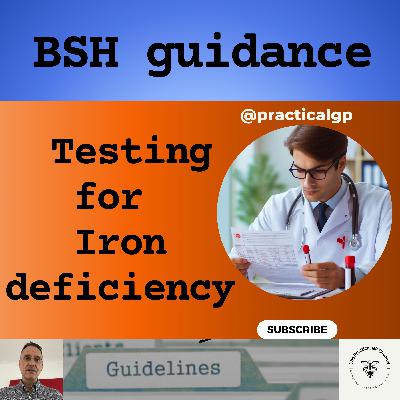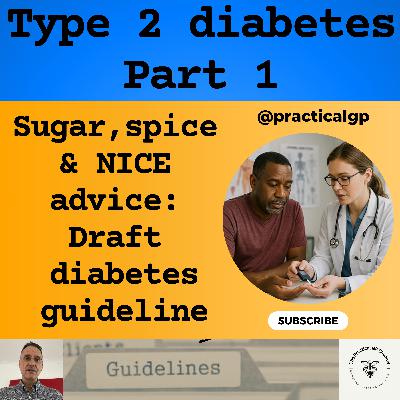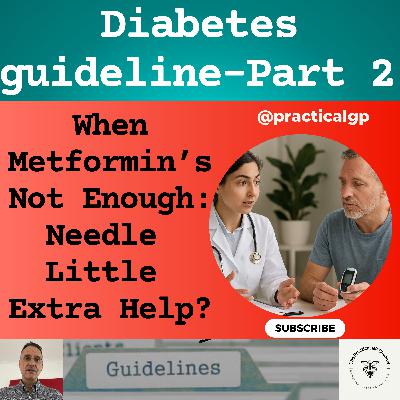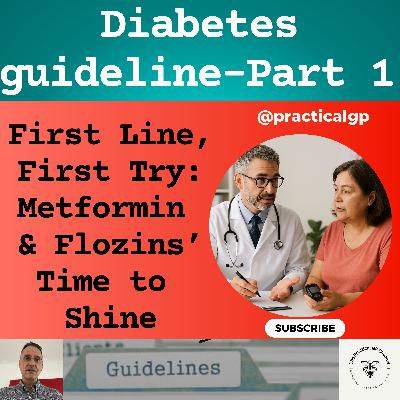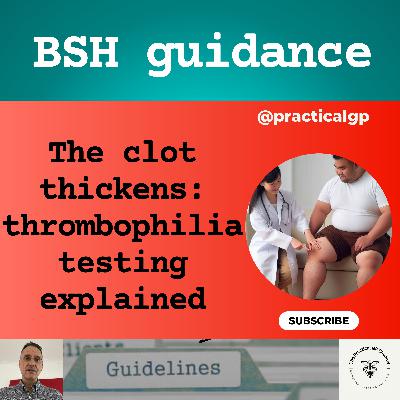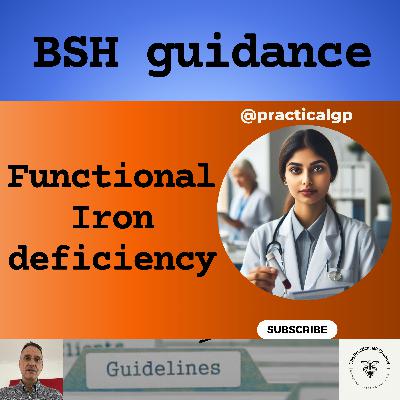Podcast - Testing for Iron Deficiency: Ironing Out the Details
Description
The video version of this podcast can be found here:
· https://youtu.be/ZdHSs-QBtac
This channel may make reference to guidelines produced by the British Society for Haematology. The content on this channel reflects my professional interpretation/summary of the guidance and I am in no way affiliated with, employed by or funded/sponsored by them.
My name is Fernando Florido (also known as Juan Fernando Florido Santana), a GP in the UK. In this episode, I will go through the guideline by the British Society for Haematology on the laboratory diagnosis of iron deficiency in adults (excluding pregnancy) and children, focusing on what is relevant in Primary Care only.
In the coming episodes, I will also cover the recommendations by the British Society for haematology on:
· The assessment of raised ferritin
· The concept of functional iron deficiency
I am not giving medical advice; this video is intended for health care professionals, it is only my summary and my interpretation of the guidelines and you must use your clinical judgement.
Intro / outro music: Track: Halfway Through — Broke In Summer [Audio Library Release]
- Music provided by Audio Library Plus
- Watch: https://youtu.be/aBGk6aJM3IU
- Free Download / Stream: https://alplus.io/halfway-through
There is a podcast version of this and other videos that you can access here:
Primary Care guidelines podcast:
· Redcircle: https://redcircle.com/shows/primary-care-guidelines
· Spotify: https://open.spotify.com/show/5BmqS0Ol16oQ7Kr1WYzupK
· Apple podcasts: https://podcasts.apple.com/gb/podcast/primary-care-guidelines/id1608821148
There is a YouTube version of this and other videos that you can access here:
- The Practical GP YouTube Channel:
https://youtube.com/@practicalgp?si=ecJGF5QCuMLQ6hrk
The link to the new guideline by the British Society for Haematology on the laboratory diagnosis of iron deficiency can be found here:
· https://onlinelibrary.wiley.com/doi/full/10.1111/bjh.17900
The link for the British Society for Haematology website can be found here
Disclaimer:
The Video Content on this channel is for educational purposes and not intended to be a substitute for professional medical advice, diagnosis, or treatment. Always seek the advice of your physician or other qualified health provider with any questions you may have regarding a medical condition. Never disregard professional medical advice or delay in seeking it because of something you have read or seen on this YouTube channel. The statements made throughout this video are not to be used or relied on to diagnose, treat, cure or prevent health conditions.
In addition, transmission of this Content is not intended to create, and receipt by you does not constitute, a physician-patient relationship with Dr Fernando Florido, his employees, agents, independent contractors, or anyone acting on behalf of Dr Fernando Florido.
Transcript
If you are listening to this podcast on YouTube, for a better experience, switch to the video version. The link is in the top right corner of the video and in the episode description.
Hello and welcome, I am Fernando, a GP in the UK. Today, we will go through the guideline by the British Society for Haematology on the laboratory diagnosis of iron deficiency, focusing on what is relevant in Primary Care only.
In the coming episodes, I will also cover their recommendations on:
· The assessment of raised ferritin
· The concept of functional iron deficiency
So, stay tuned for those!
Right, let’s jump into it.
The British Society for Haematology produces Good Practice Papers to recommend good practice in areas where there is limited evidence but where a degree of consensus is likely to be beneficial to patient care.
The laboratory diagnosis of iron deficiency is difficult, because iron homeostasis is dynamic and no single test can provide an accurate assessment of iron absorption, transport, storage, and utilisation.
Iron metabolism in adults and children can be considered equivalent, and these recommendations are applicable to both paediatric and adult practice, but it does not include pregnancy.
Let’s start by saying that iron deficiency is the most common cause of anaemia worldwide. In the UK, the prevalence of iron deficiency anaemia can go up to 6% depending on age and sex, with higher rates in certain groups like menstruating women and those aged over 85 years.
The prevalence of iron deficiency without anaemia, however, is not well documented.
In this episode we are just focusing on the laboratory assessment of iron status and not the full guidance on iron deficiency anaemia which requires a detailed history, clinical examination and the review of, for example, national gastrointestinal and gynaecology guidelines as well as other local pathways.
The British Society for Haematology has suggested an algorithm for the laboratory investigation of iron deficiency anaemia which we will review at the end. But first, let’s look at the different laboratory parameters that we will need to consider.
As you may already be aware, the main diagnostic tests in iron deficiency anaemia are a full blood count and ferritin.
So let’s now start with the red cell parameters in a full blood count. Anaemia will be confirmed if haemoglobin or Hb is below the reference range. But Hb alone does not indicate iron status and at population level, there’s considerable overlap in Hb levels between iron-replete and iron-deficient people.
Iron deficiency is typically associated with microcytic hypochromic anaemia.
But low MCV, MCH, or MCHC can also appear in other conditions, especially the thalassaemias.
Interestingly, MCV can be normal in up to 40% of iron-deficient patients, and also in cases of mixed haematinic deficiency.
There are other advanced parameters like percentage of hypochromic cells (%HRC) and reticulocyte mean Hb content which can help evaluate iron availability further.
Given that Erythrocytes contain about half of the body’s iron at any one time,
a high percentage of hypochromic cells or low reticulocyte Hb content — without thalassaemia — suggests that iron is not adequately reaching newly formed red cells, which could be due to iron deficiency or iron restriction.
Morphological changes appear in iron deficiency and generally, anisocytosis precedes hypochromia and microcytosis but blood cell morphology is not diagnostic
So, in summary, in respect of full blood counts, it is recommended that:
- If thalassaemia is not present, any of MCV, MCH, or MCHC result which is below normal could suggest iron deficiency,
- On the other hand, normal red cell indices do not exclude iron deficiency as a cause of anaemia. Further investigation may still be required if there is high clinical suspicion.
- Mean reticulocyte Hb content of <29 pg can support the diagnosis of iron deficiency if initial tests are inconclusive and finally, although not diagnostic,
- Inspection of a peripheral blood film should be performed when the diagnosis is unclear.
Let’s now move onto ferritin.
Ferritin reflects iron stores and levels <15 µg/L strongly suggest iron deficiency.
Levels up to 30 µg/L can still be consistent with deficiency but are less specific.
Ferritin acts as an acute phase protein, meaning it rises with inflammation, kidney disease, liver disease, and malignancy and, because of this, interpreting ferritin in inflammatory states can be challenging.
Formulas to correct ferritin with CRP or ESR have been proposed, but the evidence isn’t robust enough for clinical use.
So, in summary, the recommendations are that:
- In children over 5 and adults a ferritin <15 µg/L is indicative of iron deficiency.
- For children under 5 the threshold is a ferritin <12 µg/L. However,
- A ferritin level within the normal range does not exclude iron deficiency if there’s inflammation or chronic disease and further investigation is often needed.
And this is where iron studies come into play. They should not be done routinely but they should be considered when:
- FBC shows microcytic or hypochromic anaemia
- Ferritin is borderline or normal but there's suspicion of iron deficienc

